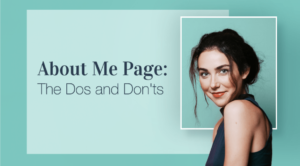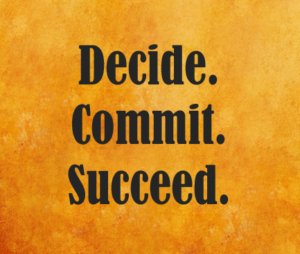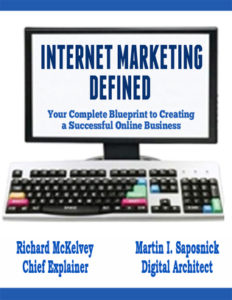Selling Yourself
Begin with your “ABOUT page”
Training Series # 11
YOUR “ABOUT” PAGE
When someone bothers to click on that little link to your “ABOUT” page they expect to learn more about YOU and your business.
They are inviting YOU into their lives; they are contemplating doing business with YOU.
This is your opportunity to sell yourself. You are being interviewed here.
Nobody likes being interviewed, but this is an easy and (should be) helpful interview. You don’t need to get all dressed up and talk to their face.
You just need to craft copy that is persuasive and inviting.
There are six principles of persuasion that will help you. And we are going to show you some of the ways that you can use them for an “About” page for your website.
Essential Properties of an About Page
The objective of an About page is to help people connect with your personality after reading your blog or a landing page hosted on your website.
You want to give information about yourself and your background, while trying to make the page sound as human friendly as possible.
The layout below will help to funnel attention to your offer.
Section 1: Headline
The headline for your about page needs to be as classy, persuasive, and exciting as possible. It should have a ”tell me more” quality. There are so many great “about” pages that start off with “About X” as the headline. The rest of the content may be fantastic, but that boring headline could easily drive people away from your page.
And it is not just about having a headline stuffed with all your keywords; you need something that will connect with your reader and encourage them to read more about your life.
Richard McKelvey
SMALL BUSINESS MARKETING GURU – CHIEF EXPLAINER – GOURMET
Marty Saposnick
TAI CHI MASTER – BUSINESS INCUBATION EXPERT – AUTHOR
Section 2: Introduction
A photo is a must on your page. People feel a c know what you look like, they will be hesitant to recommend you for a job or to their friends and family.
When you are writing an introduction, keep it as simple as possible. You do not want to ramble on for two or three pages, since that will bore anyone who is reading (THIS IS STUFF ABOUT YOU,
BUT HINT THAT THEY WILL BENEFIT SOMEHOW: LEARN SOMETHING OR GET SOMETHING THAT THEY THINK THEY NEED.)
Be concise when you talk about your company and yourself, your website, and what the readers can hope to gain from sticking around and reading other articles on your site.
Convey information in short and detailed paragraphs; it’s making it easy for the reader to switch from one point of information to another.
For example, paragraph one can talk about the site, paragraph two can talk about you, and paragraph three can talk about your interests/hobbies/other passions. By injecting your personality and a little humor you can come across as a real person. This is your goal.
Make sure that your name is visible on your blog or on your About page.
Many writers prefer to remain anonymous, and will use Twitter or Facebook names on their articles.
However, if someone wants to contact you about a business opportunity, they will want to know something close to your real name.
When you add personality insight to your about page, it will help to set you apart from your competition. Remember, you never know if your page will be seen as “link-worthy”.
Section 3: Testimonials
People can perceive your work as credible and beneficial. It it never hurts to see positive statements as a testimonial. This becomes an extra bit of self-promotion. (key concept).
Have the next area of your About page dedicated to testimonials, quotes, and other anecdotes from friends, family, and famous people who may have read your work.
These anecdotes can be quotes, simple text, or copied Tweets and Facebook posts from a sender.
Quotes add another layer of personality and humanity to your work.
Not only does it show your readers that you are worth spending their time on, but it demonstrates your appeal to others around the world.
Section 4: Personal Story
After taking the time to introduce yourself, and show that other people vouch for your credibility, talent, and personality, it is time to tell people more about yourself.
Tell them everything about yourself that you deem relevant and interesting.
You can mention;
- your age,
- where you live,
- how many cities you have visited and/or worked in,
- whether you are married and/or have kids, and
- where you went to college.
However, it is important to keep in mind why people are on your website in the first place.
They are not there to get your family history or to see how old your kids are.
They want to know more about you so that they can decide whether you are the right person who can help them.
Whether you are going to be providing them with a service, a product, or just deliver some great reading material.
Present yourself in a way that is genuine, believable, humble, and attractive.
The goal is to sell yourself without making it appear as though you are trying to sell yourself.
Do not let any of this page sound “+salesy”, otherwise it will drive people away.

Section 5: Closing the Deal
There are many reasons to start a blog site.
It may be to promote your books, share articles that you have written, or to help generate customers for your new business. Whatever your reason, it is time to encourage customers to take action.
A good idea here is to ask your visitors to make a commitment. Understand your purpose is “conversion.” In the context of online marketing it refers to the proportion of people viewing an advertisement and going on to buy the product, click on a link, etc.
Place a small opt-in box on your About page, and say you would like to send them a free (e-book, white paper or any other lead capture), for taking their time to get to know you. Lead Magnets are important tools for you to start building relationships.
Lead Magnet — noun — an irresistible bribe offering a specific chunk of value to a prospect in exchange for their contact information. They should:
- Deliver value
- Be specific
- Write a headline and use this tool: “Emotional Marketing Headline Analyzer.”
- Optimize your opt-in button e.g. get your great stuff here, not “subscribe”
Lead magnets, can be thought of as incentives, or upgrades. They are reasons that you give people in exchange for receiving their emails. You give something to your readers that is for free. If it works you readers get excited and you get an email for your list.
People like to be perceived as reliable, honest, and consistent. Once they have publicly committed to something or someone then they are much more likely to carry through with that commitment.

By this point you don’t want your call to action to be too conservative; if it sounds too obvious it’s probably perfect.
Avoid the conversion killer phrases such as:
“If you are interested…”
“Don’t forget to…”
Feel free to sign up…”
For a good example of an about page with good call to actions just check out “InternetVisionsDefined.com” tutorial on Landing Pages. It contains the following:
- Introduction
- Opt-in form
- Social proof
- Opt-in form
- Personal Story
Rambling on and on about useless things is a mistake that many people make with their About Me page.
Keep the information short, concise, relevant, and informative.
If you would not want to read the information on someone else’s About page, do not have it on your own page.
Do a study of a dozen random “About” pages, and see what elements you like and what you don’t like. Learn from observation.

